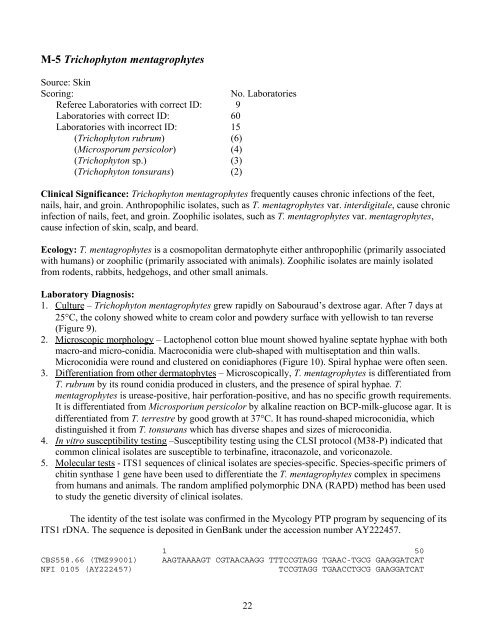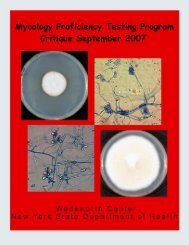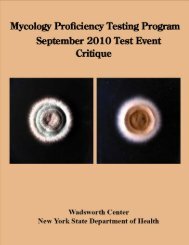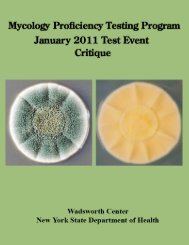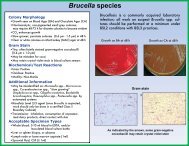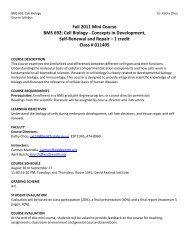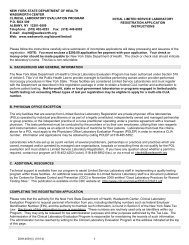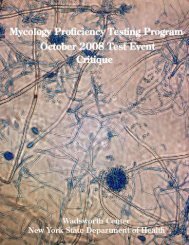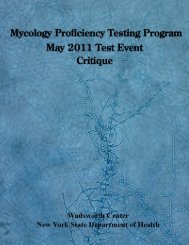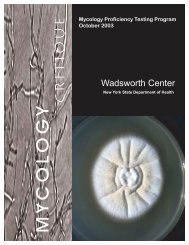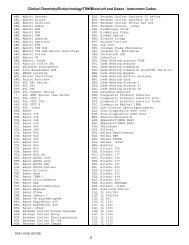M-5 Trichophyton mentagrophytesSource: SkinScoring:No. LaboratoriesReferee Laboratories with correct ID: 9Laboratories with correct ID: 60Laboratories with incorrect ID: 15(Trichophyton rubrum) (6)(Microsporum persicolor) (4)(Trichophyton sp.) (3)(Trichophyton tonsurans) (2)Clinical Significance: Trichophyton mentagrophytes frequently causes chronic infections of the feet,nails, hair, and groin. Anthropophilic isolates, such as T. mentagrophytes var. interdigitale, cause chronicinfection of nails, feet, and groin. Zoophilic isolates, such as T. mentagrophytes var. mentagrophytes,cause infection of skin, scalp, and beard.Ecology: T. mentagrophytes is a cosmopolitan dermatophyte either anthropophilic (primarily associatedwith humans) or zoophilic (primarily associated with animals). Zoophilic isolates are mainly isolatedfrom rodents, rabbits, hedgehogs, and other small animals.Laboratory Diagnosis:1. Culture – Trichophyton mentagrophytes grew rapidly on Sabouraud’s dextrose agar. After 7 days at25°C, the colony showed white to cream color and powdery surface with yellowish to tan reverse(Figure 9).2. Microscopic morphology – Lactophenol cotton blue mount showed hyaline septate hyphae with bothmacro-and micro-conidia. Macroconidia were club-shaped with multiseptation and thin walls.Microconidia were round and clustered on conidiaphores (Figure 10). Spiral hyphae were often seen.3. Differentiation from other dermatophytes – Microscopically, T. mentagrophytes is differentiated fromT. rubrum by its round conidia produced in clusters, and the presence of spiral hyphae. T.mentagrophytes is urease-positive, hair perforation-positive, and has no specific growth requirements.It is differentiated from Microsporium persicolor by alkaline reaction on BCP-milk-glucose agar. It isdifferentiated from T. terrestre by good growth at 37°C. It has round-shaped microconidia, whichdistinguished it from T. tonsurans which has diverse shapes and sizes of microconidia.4. In vitro susceptibility testing –Susceptibility testing using the CLSI protocol (M38-P) indicated thatcommon clinical isolates are susceptible to terbinafine, itraconazole, and voriconazole.5. Molecular tests - ITS1 sequences of clinical isolates are species-specific. Species-specific primers ofchitin synthase 1 gene have been used to differentiate the T. mentagrophytes complex in specimensfrom humans and animals. The random amplified polymorphic DNA (RAPD) method has been usedto study the genetic diversity of clinical isolates.The identity of the test isolate was confirmed in the Mycology PTP program by sequencing of itsITS1 rDNA. The sequence is deposited in GenBank under the accession number AY222457.CBS558.66 (TMZ99001)NFI 0105 (AY222457)1 50AAGTAAAAGT CGTAACAAGG TTTCCGTAGG TGAAC-TGCG GAAGGATCATTCCGTAGG TGAACCTGCG GAAGGATCAT22
51 100TAGCGCGCAG GCCGGAGGCT GGCCCCCCAC GATAGGGCCA AACGTCCGTCTAGCGCGCAG GCCGGAGGCT GGCCCCCCAC GATAGGGCCA AACGTCCGTC101 150AGGGGTGAGC AGATGTGCGC CGGCCGTACC GCCCCATTCT TGTCTACATTAGGGGTGAGC AGATGTGCGC CGGCCGTACC GCCCCATTCT TGTCTACATT151 200ACTCGGTTGC CTCGGCGGGC CGCGCTCTCC CAGGAGAGCC GTTCGGCGAGACTCGGTTGC CTCGGCGGGC CGCGCTCTCC CAGGAGAGCC GTTCGGCGAG201 250CCTCTCTTTA GTGGCTAAAC GCTGGACCGC GCCCGCCGGA GGACAGACGCCCTCTCTTTA GTGGCTAAAC GCTGGACCGC GCCCGCCGGA GGACAGACGC251 300AAAAAAATTC TTTCAGAAGA GCTGTCAGTC TGAGCGTTAG CAAGCAAAAAAAAAAAATTC TTTCAGAAGA GCTGTCAGTC TGAGCGTTAG CAAGCAAAAA301 350TCAGTTAAAA CTTTCAACAA CGGATCTCTT GGTTCCGGCA TCGATGAAGATCAGTTAAAA CTTTCAACAA CGGATCTCTT GGTTCCGGCA TCGATGAAGA351 400ACGCAGCGAA ATGCGATAAG TAATGTGAAT TGCAGAATTC CGTGAATCATACGCAGCAlignment of primary sequences of the ITS1 regions of T. mentagrophytes CBS 558.66 and PT specimen T. mentagrophytesNFI 0105. GenBank (http://www.ncbi.nlm.nih.gov/Genbank/index.html) accession numbers are in parentheses.Comments: Many participating laboratories were unable to correctly identify this specimen. T.mentagrophytes can be differentiated from T. rubrum and Microsporum persicolor by using BCP-milkglucoseagar. Alkalinization can be observed on BCP-milk-glucose agar for T. mentagrophytes, but nochange in pH for T. rubrum and M. persicolor. T. tonsurans is distinguished from T. mentagrophytes byits microconidia of varying shapes and sizes, and by the stimulating effect on media with thiamine.Further Reading:1. Bornkessel, A., Ziemer, M., Yu, S., Hipler, C., Elsner, P. 2005. Fulminant papulopustular tineacorporis caused by Trichophyton mentagrophytes. Acta Derm Venereol. 85: 92.2. Chang, S.E., Lee, D.K., Choi, J.H., Moon, K.C., Koh, J.K. 2005. Majocchi's granuloma of the vulvacaused by Trichophyton mentagrophytes. Mycoses. 48: 382-384.3. Koc, A.N., Silici, S., Ayangil, D., Ferahbas, A., and Cankaya, S. 2005. Comparison of in vitroactivities of antifungal drugs and ethanolic extract of propolis against Trichophyton rubrum and T.mentagrophytes by using a microdilution assay. Mycoses. 48: 205-210.4. Ozawa, H., Okabayashi, K., Kano, R., Watanabe, S., and Hasegawa, A. 2005. Antifungal activities ofthe combination of tacrolimus and itraconazole against Trichophyton mentagrophytes. J Vet Med Sci.67: 629-630.5. Pounder, J.I., Williams, S., Hansen, D., Healy, M., Reece, K., and Woods, G.L. 2005. Repetitivesequence-PCR-basedDNA fingerprinting using the Diversilab system for identification of commonlyencountered dermatophytes. J Clin Microbiol. 43: 2141-2147.23
- Page 2 and 3: Dr. Vishnu Chaturvedi, DirectorDr.
- Page 4 and 5: Schedule of 2010 Mycology PT Mailou
- Page 6 and 7: ANSWER KEYMycology - GeneralSpecime
- Page 8 and 9: TEST STATISTICSGeneralYeastOnlyAnti
- Page 10 and 11: 4. Pfaller, M.A., Messer, S.A., Boy
- Page 12 and 13: M-2 Aspergillus terreusSource: Bron
- Page 15 and 16: A. B.Figure 3. (A) Seven-day-old, p
- Page 17 and 18: vitro antifungal resistance within
- Page 19 and 20: M-4 Aspergillus clavatusSource: Bon
- Page 21: A. B.Figure 7. (A) Five-day-old, Gr
- Page 25 and 26: A. B.Figure 9. (A) Nine-day-old, wh
- Page 27 and 28: 1. Abdel-Hafez AI and el-Sharouny,
- Page 29 and 30: YEAST DESCRIPTIONSY-1 Candida albic
- Page 31 and 32: Further Reading:1. Bartie, K.L., Wi
- Page 33 and 34: Y-2 Candida dubliniensisSource: Spu
- Page 35 and 36: Alignment of primary sequence of th
- Page 37 and 38: Y-3 Candida lipolyticaSource: Tissu
- Page 39 and 40: Figure 17. Seven-day-old, white to
- Page 41 and 42: 251TCGCATCGAT GAAGAACGCA GCTCGCATCG
- Page 43 and 44: Figure 19. Seven-day-old, colony cr
- Page 45 and 46: 201 250ATCTCTTGGC TCTCGCATCG ATGAAG
- Page 47 and 48: Figure 21. Seven-day-old, mucoid, s
- Page 49 and 50: 4. Lee, J.S., Shin, J.H., Kim, M.N.
- Page 51 and 52: ANTIFUNGAL SUSCEPTIBILITY TESTING F
- Page 53 and 54: Table 5. Distribution of Interpreta
- Page 55 and 56: susceptibility testing for molds al
- Page 57 and 58: Further Reading:1. Barry, A.L., Pfa
- Page 59 and 60: DIRECT DETECTION (CRYPTOCOCCUS NEOF
- Page 61 and 62: Table 6. Summary of quantitative as
- Page 63 and 64: 26. Murray, P.R., Baron, E.J., Pfal


